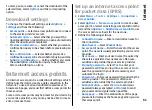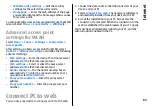
Travelling
Need directions? Looking for a restaurant? Your Eseries
device has the tools to get you where you want to be.
About GPS and satellite
signals
The Global Positioning System (GPS) is a worldwide radio
navigation system that includes 24 satellites and their
ground stations that monitor the operation of the
satellites. Your device has an internal GPS receiver.
A GPS terminal receives low-power radio signals from the
satellites and measures the travel time of the signals. From
the travel time, the GPS receiver can calculate its location
to the accuracy of metres.
To enable or disable different positioning methods, such
as Bluetooth GPS, select
Menu
>
Tools
>
Settings
>
General
>
Positioning
>
Positioning methods
.
About satellite signals
If your device cannot find the satellite signal, consider the
following:
•
If you are indoors, go outdoors to receive a better
signal.
•
If you are outdoors, move to a more open space.
•
Ensure that your hand does not cover the GPS antenna
of your device.
•
If the weather conditions are bad, the signal strength
may be affected.
•
Establishing a GPS connection may take from a couple
of seconds to several minutes.
Satellite status
To check how many satellites your device has found, and
whether your device is receiving satellite signals, select
Menu
>
GPS
>
GPS data
>
Position
>
Options
>
Satellite status
. If your device has found satellites, a bar
for each satellite is shown in the satellite info view. The
longer the bar, the stronger the satellite signal. When your
device has received enough data from the satellite signal,
the bar turns black.
Positioning settings
Select
Menu
>
Tools
>
Settings
>
General
>
Positioning
.
To use a specific positioning method to detect the location
of your device, select
Positioning methods
.
To select a positioning server, select
Positioning server
.
64
Travelling






























